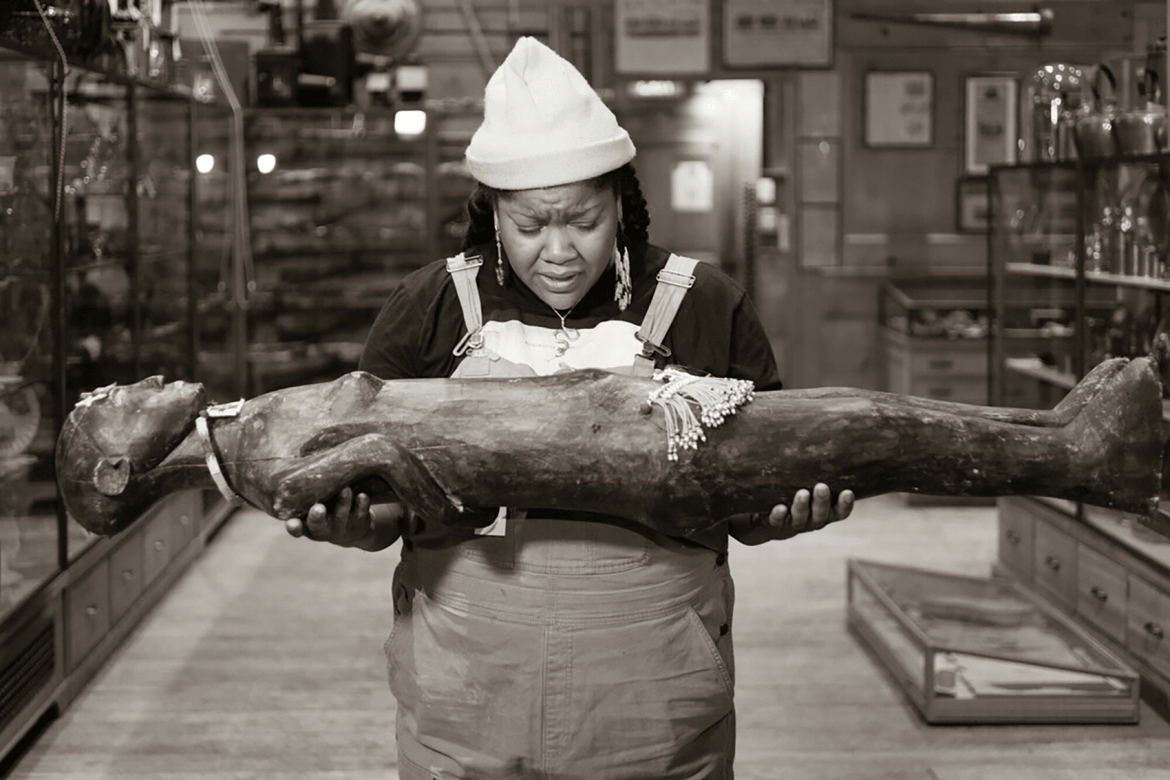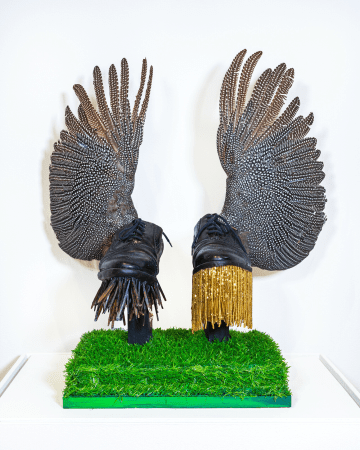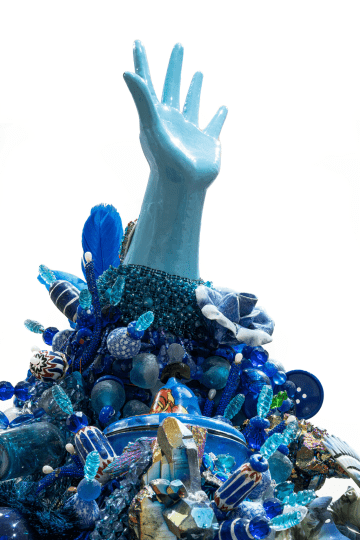vanessa german’s new exhibition at the Art Museum

A new exhibition, “vanessa german — THE RAREST BLACK WOMAN ON THE PLANET EARTH,” will be on view at the Mount Holyoke College Art Museum (MHCAM) to celebrate the seventy-fifth anniversary of the Joseph Allen Skinner Museum bequest.

Collection of the artist, courtesy of Kasmin, New York
Photo Laura Shea
A new exhibition, “vanessa german — THE RAREST BLACK WOMAN ON THE PLANET EARTH,” is now on view at the Mount Holyoke College Art Museum (MHCAM) through May 28, 2023. The exhibition — featuring video and sculpture by the artist, activist, performer and poet vanessa german (who uses lowercase letters in her name) — navigates ancestral memory and the contemporary landscapes of race, politics and the pandemic with a uniquely powerful and profound approach.
The artist will also be on campus for a special opening event on Thursday, October 13, at 5:30 pm in Chapin Auditorium, and it is free and open to the public. The event is made possible by the Patricia and Edward Falkenberg Lecture Fund. The exhibition is made possible by the Susan B. Weatherbie Exhibition Fund and the Leon Levy Foundation.
The genesis of the exhibition was german’s response to the Joseph Allen Skinner Museum, an early twentieth-century cabinet of curiosities, located on Route 116 just north of campus. The collection, which ranges from Lakota Sioux beadwork and a merchant ship’s carved figurehead to nineteenth-century folk art portraits, dinosaur tracks and Samurai swords, is an impressive and unwieldy trove of over 7,000 fascinating objects. Skinner, a local silk magnate and philanthropist who spent a lifetime acquiring objects from around the world, left his museum and collection to Mount Holyoke in a 1946 bequest. The Skinner Museum has also reopened on Saturdays from 11 am to 5 pm (through December 10; spring hours are to be determined).
The video

Collection of the artist, courtesy of Kasmin, New York
Photo Laura Shea
german began with a question: “How do we decolonize a thing, a museum, a collection?” Her answer — captured in a moving video titled “vanessa german is THE RAREST BLACK WOMAN ON THE PLANET EARTH” — turned into an emancipatory endeavor: to touch every object in the Skinner collection. In this way, the artist felt that the story of the Skinner Museum could be reanimated and retold.
The artist explains that through touching every Skinner object, she owns “the story of the Skinner Museum. We own the truth that more than one thing is happening at the same time in the same place. And then into the future of futures past — all points in space and time are connected. Everything is touched.”
Through this process, she discovered that holding some of the objects created profound feelings: When she held pieces of Stonehenge and the Great Pyramid of Giza, she was moved to tears and began to shake as if the objects were offering her a spiritual message.
The installation

Collection of the artist, courtesy of Kasmin, New York
Photo Laura Shea
Inspired by the Skinner collection, german decided to create her own museum, a sacred space of healing. german invited the Mount Holyoke community to join her in the creation of a body of work that would focus on the topic of emancipation. With MHCAM student interns, german created a series of prompts and calls for materials on campus. Thought-provoking questions were asked, such as “What do you need forgiveness for?” and “What are you currently learning and un-learning?” Posters and collection stations were installed across campus to gather written responses, personal objects and clothing, which resulted in an outpouring of words and belongings. german then incorporated the anonymously written responses along with the objects — including boots, figurines and jewelry — to create all the artworks for the exhibition. The result is her mixed-media installation titled “MUSEUM OF EMANCIPATORY OBJECTS,” which includes more than a dozen of the artist’s iconic power figures and other assemblages.
Aaron F. Miller, associate curator of visual and material culture, who worked with german throughout the project, explained, “It was incredible to witness the process and to see vanessa grappling with this complicated work and then reshape it into this profound project of healing — for the objects, for herself and for all of these different audiences she has invited into the experience.”

Collection of the artist, courtesy of Kasmin, New York
Photo Laura Shea
“vanessa german — THE RAREST BLACK WOMAN ON THE PLANET EARTH” also features photographs taken by Laura Shea, the museum’s photographer, who documented the artist’s progress, capturing meaningful moments of german with many of the objects she encountered. Visitors are invited to take home a small offering from the artist, a piece of rose quartz, a mineral associated with unconditional love and healing.
The exhibition is the second in the two-year “Skinner Museum 75” exhibition series, which commemorates the seventy-fifth anniversary of the 1946 Skinner bequest to Mount Holyoke College.
Tricia Y. Paik, Florence Finch Abbott director, Mount Holyoke College Art Museum, noted, “We first invited vanessa in 2017 to develop a show for this seventy-fifth anniversary, but due to COVID, we had to postpone the exhibition. That’s when german switched course to her extraordinary idea of touching every object in the Skinner Museum. Her conceptual project is a remarkable, radical act and has now become a powerful chapter in both the history and future of the Skinner Museum.”
